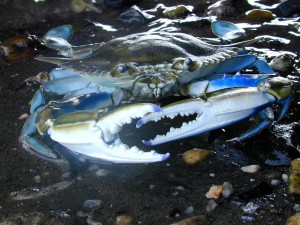by Matt Ogburn and Tuck Hines
To some following the blue crab recovery, the news earlier this month may have come as a shock. In 2012, the Chesapeake-wide Winter Dredge Survey estimated a record 764 million blue crabs in the Bay—the highest seen since 1991. Juvenile crab densities jumped to their highest levels ever. Then the 2013 survey released April 19 saw both those numbers drop.
Managers greeted the dwindling juvenile population with some depression. But those numbers may not matter as much, according to biologists Tuck Hines and Matt Ogburn of the Smithsonian Environmental Research Center. Ecologists at SERC have been tracking blue crabs for more than 30 years, almost a decade before the winter dredge survey began. They’ve discovered the population that really needs watching is the spawning females. Here is what the numbers are telling us:
1. Female protection is working overall. The 2008 change in crab fishery management targeted protection of spawning females. In four of the five years since then, the Winter Dredge Survey has recorded higher numbers of mature females and all females bigger than 2.4 inches compared to the period of very low levels from approximately 1994 to 2008. This indicates a positive outcome of reduced fishing pressure on female crabs.
2. To increase juvenile crabs, we need to protect their mothers. It is not surprising that the number of juveniles in the 2013 Winter Dredge Survey is very low. The number of females in 2012 that formed the spawning stock was near the same record low levels of great concern during the late 1990s and 2000-2008 and was unlikely to produce a large number of small juveniles in the 2013 Winter Dredge Survey. This emphasizes the importance of protecting the female spawning stock.
3. Survival matters—winter numbers alone don’t predict reproduction. The number of females in the Winter Dredge Survey provides a projection of the number of spawners in the coming summer, and into the following summer after that. But it is not a direct measure of the amount of spawning taking place. Following the Winter Dredge Survey, female crabs in Maryland need to migrate to, and in the case of juveniles over-winter in, the lower Bay before actually spawning. In order to determine the actual amount of spawning each summer, we need a much more accurate measure of factors regulating mortality (survival) of crabs from winter to summer, including juvenile mortality and the components of the fishery in various parts of the Bay, AND their reproductive success/output.
4. Location matters. Our sampling last summer (2012) indicated that the large number of juveniles recorded in the 2012 Winter Dredge Survey did not result in large numbers of juveniles in Maryland waters of the upper Chesapeake Bay.
5. It’s too early to blame the red drum. The statement that the increase in juvenile red drum was the cause of the mortality of 2012 juveniles should be viewed with caution and skepticism. While juvenile crabs may be important in the diet of red drum, it has not been demonstrated that predation by red drum is a major factor in regulating juvenile crab abundance. Our long-term experimental data in the upper Bay indicates that fish predation is not a major factor regulating juvenile crab survivorship, and we did not observe this type of predation in 2012. The biggest threat to juvenile crabs is still predation by adult crabs. The 2012 results were entirely consistent with juvenile crab mortality being directly related to numbers of large crabs.
6. We need to learn more about why females don’t spawn. The concern about poor reproduction of female blue crabs is a major ongoing focus of research in our laboratory. We need to understand more about the factors regulating the production of egg sponges and the role that males play in supplying enough sperm for females to fertilize eggs during their first AND second spawning seasons.
Dr. Tuck Hines is a marine biologist with over 30 years of experience working on blue crabs in Chesapeake Bay. His research addresses broad problems of population and community ecology using long-term quantitative sampling and innovative experiments at multiple spatial and temporal scales. His studies analyze human impacts and natural change in estuarine and marine systems.
Dr. Matt Ogburn is a Postdoctoral Research Fellow at the Smithsonian Environmental Research Center and author of the Blue Crab Blog. In addition to his work in Chesapeake Bay, he has studied blue crabs in North Carolina and Georgia. His other research involves using a combination of long-term data and directed field work to study estuarine ecology, fish biology, shrimp behavior, oyster restoration and other topics.


